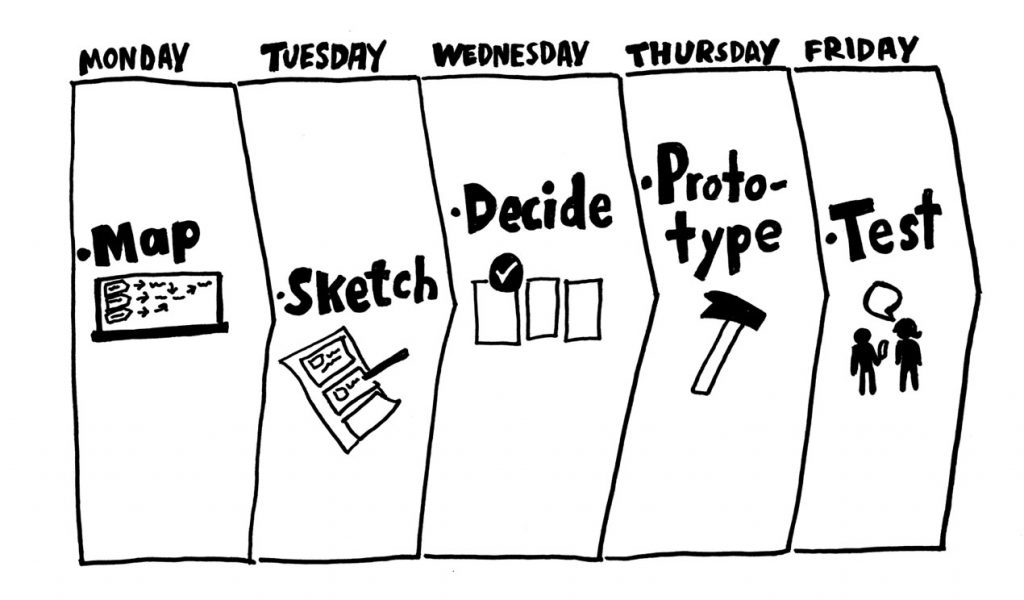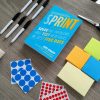On what a design sprint is, but also what it’s not
When I started at KLM Royal Dutch Airlines’ Digital Transformation program a year ago, my colleagues had ran 3 design sprints in total. By now, we have facilitated somewhere around 15 sprints so far. We’ve covered a range of topics: from rostering for employees to a corporate communications philosophy, and from cabin crew training to employees’ personal development.
In short, a design sprint is a five day process in which you solve a fundamental problem within an organization, using a multidisciplinary team. Without diving into what a design sprint exactly encompasses (for that read this article), I would like to share our most important learnings from the past 12 months.
“I can’t clear my schedule’ is no excuse”
Part of a design sprint’s value comes from having the right people in the same room for the entire week working hard towards a common goal. This means there is no room for dropping in and out because you have other important meetings and e-mails you have to get to. The results from sprints where we had people dropping in and out were less than the ones where we had full-time commitment and focus from the right people. Yes, this will require you as facilitator to keep your back straight and dealing with some scheduling issues. But if people are not willing to clear a week in their schedule they apparently don’t find the problem important enough. Of course, there’s a catch: if there are people who you absolutely need to involve that can’t make it the entire week, see if you can invite them as an expert on Monday.
Embrace the process
Many people ask ‘But what will I get at the end of the week?’. My answer is often: ‘I don’t know, but we will have something’. I learned to embrace this ambiguity and the feeling of not knowing on Monday where you will end up on Friday by now. Key is conveying this confidence to your participants: it will feel weird and fuzzy to them on Monday, but they won’t be able to work without it on Friday. Explain why certain steps are necessary, and what the added value of all these weird activities is to your participants.
“But what will I get at the end of the week?”
Pressure works
A design sprint is a pressure cooker: you’ll dream, build, and test a solution in one week. So make sure once you’ve convinced the right people to clear their schedule, you’re ready to commit yourself to the 1-week deadline. Don’t find some lame excuse to move your deadline, done is done. We have built things in a week that would normally have taken take months of discussions just by locking people together in one room for a week. Yes, that will require taking making assumptions and just trying things out. Just make sure you’re aware what assumptions you’ve made and how you can test them with your users at the end of the week. Use time pressure to your advantage: make sure you get things done in order to end up with valuable learnings by the end of the week.

Get the right team
Getting the most out of a design sprint requires the right people in the room, with the right roles and mindset. Make sure you invite people who are willing to commit their time, come with an open mind, and are up for something a bit out of their comfort zone. Selecting the right kind of people will make sure participants start to live the idea on their own by the end of the week. In terms of roles we usually aim for a combination of business stakeholders providing their own expertise, combined with a few designers from our team. Make sure you do your research upfront: who should be involved in the project, who may oppose it (and should thus be involved early), and who can provide valuable expertise? Mix this with some seasoned designers to be able to do the heavy lifting, and provide the creative spark you’re looking for. Selecting the right team upfront will help you create a great, fitting solution for your problem.
Don’t do sprints back to back
There have been weeks where we had design sprints lined up back to back, with the same team in charge of facilitation. Don’t do this. Really, just don’t. Facilitating a design sprint takes energy and focus, after which you need to recharge in order to be able to bring your A-game in the next design sprint. A good design sprint also needs work upfront (e.g. scoping the problem, doing extra research, composing the team) and afterwards (collecting materials, learnings, and prototypes). Make sure you take some time in between will give you the time for this, as well as help improve the result by recharging yourself.
Don’t fall in love with the result
Design sprints are not a silver bullet for doing all the necessary design for your project in one week. So don’t get too attached to the actual prototype you build during the week. You will take shortcuts along the way, some of which may be right, others are not. So make sure you focus on keeping the learnings from the user test, and detach yourself from the actual facade you have built in a day. Take time to reflect on the result and the things you’ve learned. Re-think and re-test your solution again if needed.
Shortcut to failing and learning
Design sprints are a great tool for getting sh*t done under pressure, if used properly. Take great care in your preparation and make sure you collect all the ideas and learnings at the end of the week. We’ll definitely continue using design sprints at KLM Digital Transformation to kickstart all kinds of topics, by shortening the road to failure and learning
— Vincent Baas







